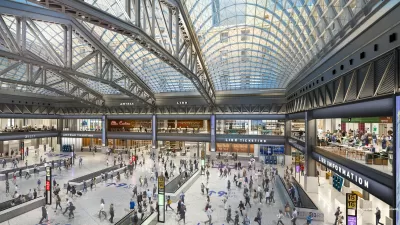Michael Kimmelman, newish architecture critic for The New York Times, adds his two cents to the decades old discussion of how to improve Penn Station. His solution starts with moving Madison Square Garden.
Kimmelman lays out the key elements of the ongoing argument for the need to renovate Penn Station, "probably the busiest transit hub in the Western world," and the sad reality that current plans to renovate the Farley Post Office building as Moynihan Station would only improve conditions for 5% of its daily passengers.
I don't think many would quibble with the need to improve Penn Station, but what has eluded the dozens of developers, planners, architects, and public officials over the years is an achievable plan to rehabilitate the existing Penn Station. Of course, Kimmelman's idea for removing Madison Square Garden is not new. As recently as the height of the building boom in 2007, planning was far along (led a public/private development partnership) to provide a new basketball arena in the western half of the Farley Post Office building, allowing for the wholesale renovation of the existing Penn Station.
So, what has changed since 2007, besides the crash of the real estate environment that made such grand plans seem achievable? Kimmelman hopes that the proposed redevelopment of the Javits Center along with "the glamour of a new arena alongside the High Line, with the boon of the No. 7 extension and the added benefit of dedicated bus service from Penn Station to 34th Street and 11th Avenue," will provide an adequate draw.
FULL STORY: Restore a Gateway to Dignity

Study: Maui’s Plan to Convert Vacation Rentals to Long-Term Housing Could Cause Nearly $1 Billion Economic Loss
The plan would reduce visitor accommodation by 25,% resulting in 1,900 jobs lost.

North Texas Transit Leaders Tout Benefits of TOD for Growing Region
At a summit focused on transit-oriented development, policymakers discussed how North Texas’ expanded light rail system can serve as a tool for economic growth.

Why Should We Subsidize Public Transportation?
Many public transit agencies face financial stress due to rising costs, declining fare revenue, and declining subsidies. Transit advocates must provide a strong business case for increasing public transit funding.

How to Make US Trains Faster
Changes to boarding platforms and a switch to electric trains could improve U.S. passenger rail service without the added cost of high-speed rail.

Columbia’s Revitalized ‘Loop’ Is a Hub for Local Entrepreneurs
A focus on small businesses is helping a commercial corridor in Columbia, Missouri thrive.

Invasive Insect Threatens Minnesota’s Ash Forests
The Emerald Ash Borer is a rapidly spreading invasive pest threatening Minnesota’s ash trees, and homeowners are encouraged to plant diverse replacement species, avoid moving ash firewood, and monitor for signs of infestation.
Urban Design for Planners 1: Software Tools
This six-course series explores essential urban design concepts using open source software and equips planners with the tools they need to participate fully in the urban design process.
Planning for Universal Design
Learn the tools for implementing Universal Design in planning regulations.
City of Santa Clarita
Ascent Environmental
Institute for Housing and Urban Development Studies (IHS)
City of Grandview
Harvard GSD Executive Education
Toledo-Lucas County Plan Commissions
Salt Lake City
NYU Wagner Graduate School of Public Service



























